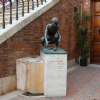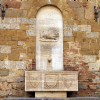 | Lodovico (Vico) Consorti was born in Semproniano, in southern Tuscany (country then included in the City of Roccalbegna). From 1919 to 1926, with a one-year interruption for military service, he attended the course with profit of sculpture at the Art Institute of Siena, directed by Fulvio Corsini: he collaborates with the execution of the Monument to the fallen of World War I Torrita di Siena in 1925 and in the same year, he made his war memorial Roccalbegna, followed by the War Memorial Petricci (1927) and Ponte Egola (Santa Croce) in 1928.
In 1930 this is the first Quadrennial National Art in Rome and the International dell'Orafo at the Venice Biennale, followed by numerous appearances at many leading national and Tuscan in a period of intense work, during which realizes the transformation of crypt of San Domenico in Siena in Shrine of the Fallen fascists, do the four reliefs of a pylon of the bridge Duca d'Aosta to Rome, a monument to the House of Maimed in Naples and the relief in travertine on the building of the Government of Livorno, assignments awarded following contests.
The years of war impose an abrupt brake activity: Consorti out of the studio in Rome and settled with his family in Siena, where a relationship of strong ties estimate the Count Guido Chigi, a lover of chamber music and important figure charismatic Sienese cultural environment. For him Vico run the door of Gratitude for the Duomo of Siena, which opened Aug. 16, 1946, as the fulfillment of the vow for the salvation of the city made two years before the Sienese citizenship. It 's the first of five monumental bronze doors made by him, a first sculptural recognized by the citizens of Siena that with familiarity and affection it appealed "Vico of the door." Participate In fact, the competition of the doors of St. Peter's in Rome and is chosen for the implementation of the Holy Door solemnly opened in the Jubilee of 1950, soon after makes the bronze doors for the church of Ludriano (Brescia), commissioned by Count Antonio Folonari and completes the series in 1966 with the main door of the sanctuary of Oropa in Biella, the biggest God has done.
Vico resumes his life as a sculptor in the study of Rome and Siena, from which now demands more work from 1959 to 1965, on an annual basis, creates portraits of famous musicians in the Villa Chigi in Castelnuovo Berardenga, for the lands Siena runs the fountains of the dragon and the porcupine; Istuto Sclavo for the bust of Sabin, school Pascoli a panel wall reliefs in bronze and ceramic, the series of portraits of the Popes in marble placed in the portico of the Sanctuary of Santa Caterina and still works for the various offices of the Monte dei Paschi.
Vico with emotion receives the prize of the Griffon golden assigned by the city of Grosseto for artistic merit, a year before going off to Siena July 1, 1979, after a life dedicated to rigorous and coherent sculpture. |


